Instructions for Side by Side Printing
- Print the notecards
- Fold each page in half along the solid vertical line
- Cut out the notecards by cutting along each horizontal dotted line
- Optional: Glue, tape or staple the ends of each notecard together
Foundations of Biology Final Test 1
front 1 Which of the following have a four-chambered heart? | back 1 Birds |
front 2 Certain Nutrients are considered "essential" in the diets of some animals because | back 2 These animals are not able to synthesis these nutrients |
front 3 Organisms with circulating body fluid that is distinct from the fluid that directly surrounds the body's cells are likely to have a? | back 3 Closed circulatory system |
front 4 In the digestive system, peristalsis is? | back 4 Smooth muscle contractions that move food along the esophagus |
front 5 Carbon Dioxide levels in the blood and cerebrospinal fluid affect its pH. This enables the organism to sense a disturbance in the gas levels as...? | back 5 The medulla oblongata, which is in contact with the cerebrospinal fluid, monitors pH and uses this measure to control breathing. |
front 6 PKU (phenylketonuria) is a hereditary condition, in which infants and young children who ingest the amino acid phenylalanine risk serious neurological damage. However, the risk of damage can be substantially reduced by the severe restriction of phenylalanine in the diet. Which of the following in the nutritional concept that forms the basis for this preventative treatment? | back 6 Essential Nutrients |
front 7 Hypoglycemia, or low levels of glucose in the blood of a healthy human, is 'corrected" by a(n) | back 7 Increase in secretion of glucagon |
front 8 In a cold and yet survivable environment, an ectoderm is more likely to survive an extended period of food deprivation than would an equally sized endotherm because ectoderms | back 8 invest little energy in temperature regulation |
front 9 After surgical removal of an infected gallbladder, a person must be especially careful to restrict his or her dietary intake of? | back 9 Fat |
front 10 Coutercurrent exchange in the fish gill helps to maximize | back 10 diffusion |
front 11 The bile salts function in fat digestion by? | back 11 dispersing big droplets of fats to small droplets |
front 12 The only vertebrates in which the blood flows directly from respiratory organs to body tissues without first returning to the heart are? | back 12 Fishes |
front 13 The body's automatic tendency to maintain a constant internal environment is termed | back 13 homeostasis |
front 14 Human red blood cells in an artery of the left arm is on its way to deliver oxygen to a cell in the thumb. To travel from the artery to the thumb and the back to the left ventricle, this red blood cell must pass through? | back 14 two capillary beds |
front 15 An example of a properly functioning homeostatic control system is seen when? | back 15 The kidneys excrete salt into the urine when dietary salt levels rise |
front 16 Without functioning parietal cells an individual would | back 16 not be able to initiate protein digestion in the stomach |
front 17 The most important chemical stimuli leading to increased rate and depth of breathing is? | back 17 concentration of CO2 in the blood |
front 18 Which common event most closely resembles negative feedback? | back 18 The furnace turns off when the temperature in the room reaches the set point |
front 19 After ingestion, the first type of macromolecule to be enzymatically attacked in the human digestive system is? | back 19 Carbohydrates |
front 20 In the circulatory system of humans, how is most of the carbon dioxide transported? | back 20 Bicarbonate ions in the plasma |
front 21 Stomach acid | back 21 activates pepsinogen into pepsin |
front 22 Which of the following organs is incorrectly paired with its function? | back 22 Large intestine and bile production |
front 23 An example of a connective tissue is the | back 23 Blood |
front 24 An advantage of a complete digestive system over a gastrovascular cavity is that the complete system | back 24 allows specialized functions in specialized regions |
front 25 An increase in pH 7.2 to pH 7.4 around hemoglobin causes | back 25 an increase in the affinity of hemoglobin to bind to oxygen molecules |
front 26 Increased levels of glucose levels in blood after a meal may trigger | back 26 insulin release from the pancreas |
front 27 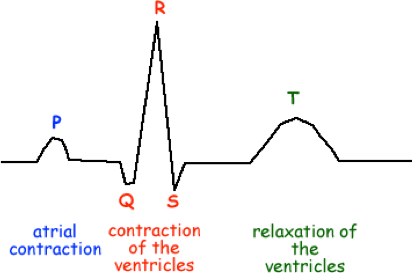 Use the figure above to answer this question. When does contraction of the atria begin? | back 27 immediately after the P-wave |
front 28 Digestive secretions with a pH of 2 are characteristic of the? | back 28 stomach |
front 29 Air rushes into the lungs of humans during inhalation because | back 29 the rib muscles and diaphragm are contracted, increasing the lung volume |
front 30 Three types of cells which are present in the gastric glands are responsible for some secretion of gastric juice. ____ cells secrete pepsinogen (an inactive form of digestive enzyme pepsin). _____ cells lubricate and protect the cells lining in the stomach. ____ cells secrete HCl | back 30 chief, mucus, parietal |
front 31 Which of the following explains the reason that the velocity of blood blow is the lowest in capillaries? | back 31 The total cross-sectional area of the capillaries is greater than the total cross-sectional area of the arteries of any other part of the circulatory system |
front 32 The bile salts | back 32 emulsify fats in the duodenum |
front 33 Stomach cells are moderately well adapted to the acidity and protein-digesting activities in the stomach by having | back 33 A thick mucous secretion and active mitosis in epithelial cells |
front 34 Why is gas exchange more difficult for aquatic animals with gild than for terrestrial animals with lungs? | back 34 water contains much less O2 than air per unit volume |
front 35 A rabbit taken from a meadow near sea level and moved to a meadow high on a mountainside would have some trouble breathing. Why? | back 35 the partial pressure of O2 in the air at high elevations is lower than at sea level |
front 36 Cyanide poisons mitochondria by blocking the final step in the electron transport chain. Human red blood cells placed in an isotonic solution containing cyanide are likely to? | back 36 be unaffected |
front 37 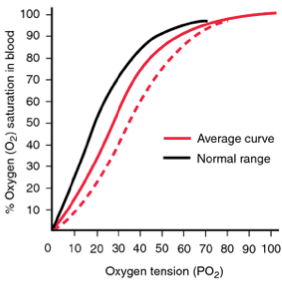 The Bohr shift on the oxygen-hemoglobin dissociation curve (see figure 1 below) is produced by changes in? | back 37 pH |
front 38 which of the following organisms breathe through tracheae? | back 38 insects |
front 39 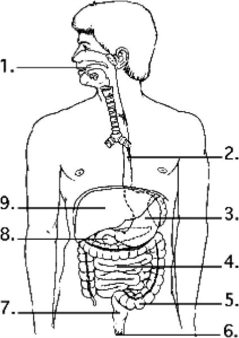 Agents that help emulsify fats are produced by? | back 39 9 |
front 40 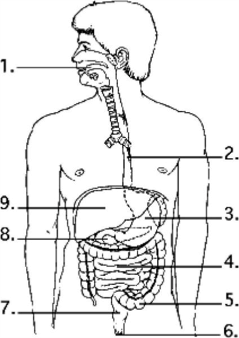 What structures are involved in the digestion of carbohydrates? | back 40 1 and 4 |
front 41 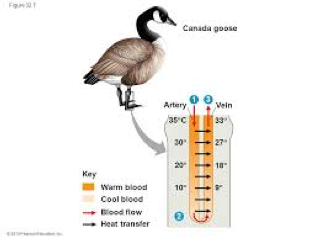 the thin horizontal arrows in the figure show that? | back 41 The warmer arterial blood transfers hear to the cooler venous blood |
front 42 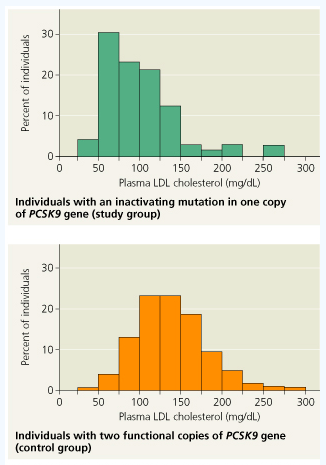 What percentage of individuals in the study group had an LDL level below 100 mg/dL? | back 42 about 58% |
front 43 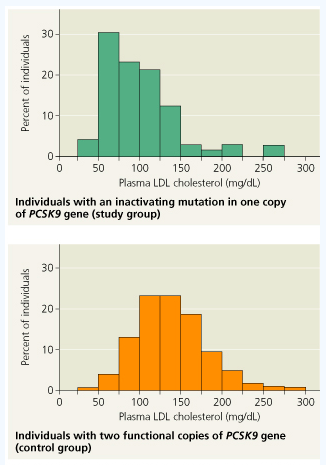 what percentage of individuals in the control group had an LDL level below 100 mg/dL? | back 43 17% |
front 44 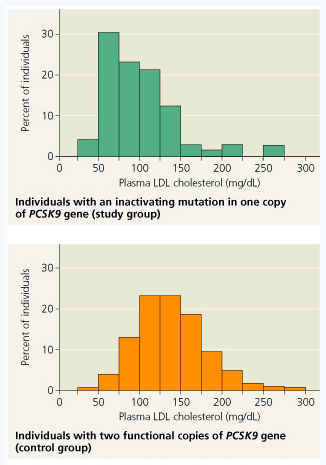 Based on these two histograms what conclusion can you draw? | back 44 On average, individuals with an inactivating mutation in the PCSK9 gene have lower plasma LDL levels than wild type individuals |
front 45 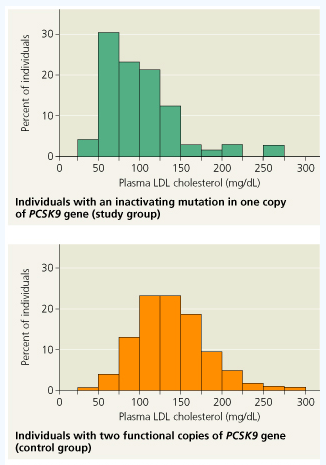 How would you compare the risk of cardiovascular disease between the study group and the control group? | back 45 the study group has a lower risk than the control group |
front 46 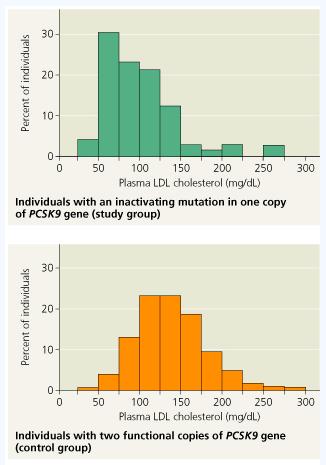 what is the best explanation for the fact that the two histograms overlap as much as they do? | back 46 many factors in addition to PCSK9 enzyme activity affect plasma LDL levels |
front 47 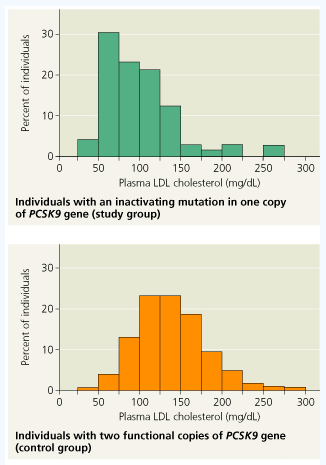 Now consider two individuals with a plasma LDL level of 160 Mg/dL, one from the study group and one from the control group. What do you predict regarding their relative risk for cardiovascular disease? | back 47 the risk is equal because their LDL levels are the same |
front 48 The direction of blood flow in the fish gills is opposite the direction of eater flow past the gills. Which of the following should be expected if the structural relationship represents a countercurrent exchange mechanism for O2? | back 48 A net movement of oxygen from water into blood occurs along the entire distance where blood and water are in close contact |
front 49 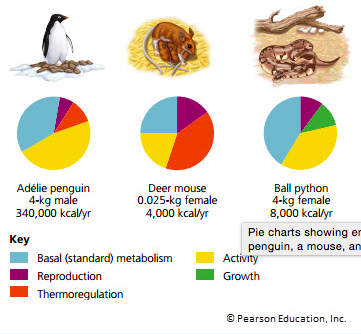 What percentage of the mouse's energy budget goes to basal metabolism? | back 49 about 25% |
front 50 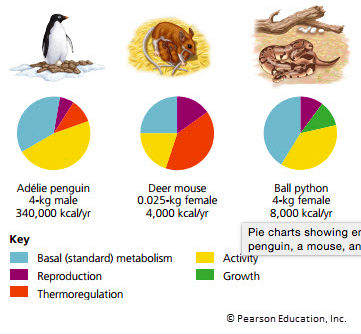 without considering the sizes of wedges, how do three pie charts differ in which function they include? | back 50 unlike the penguin and the mouse charts the python chart included growth but does not include thermoregulation |